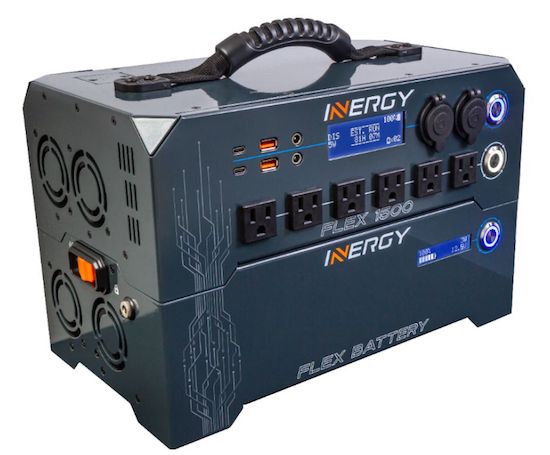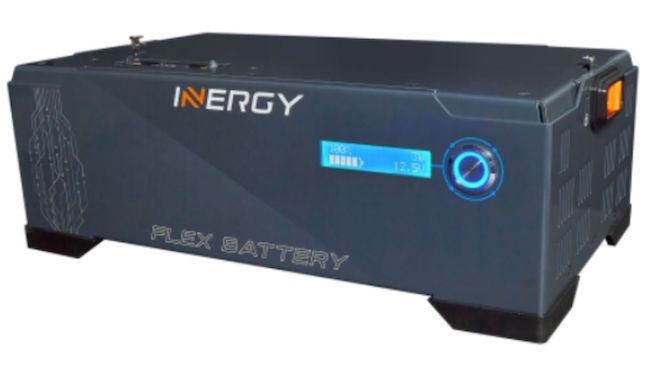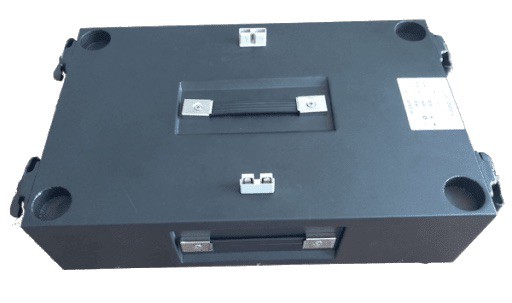In many cases, solar generators, or “portable power stations”, don’t have replaceable batteries. This means that once their batteries are used up, you would have to get an entirely new system.
With replaceable batteries, you can retain the lifetime value of the generator by only spending money on a new battery after it’s worn out.
Below is a synopsis of the four solar generators with replaceable batteries that I will be going over in this article.
| Model | Yeti 400 | Yeti 1250 | Flex | Titan |
|---|---|---|---|---|
| Brand | Goal Zero | Goal Zero | Inergy | Point Zero Energy |
 | 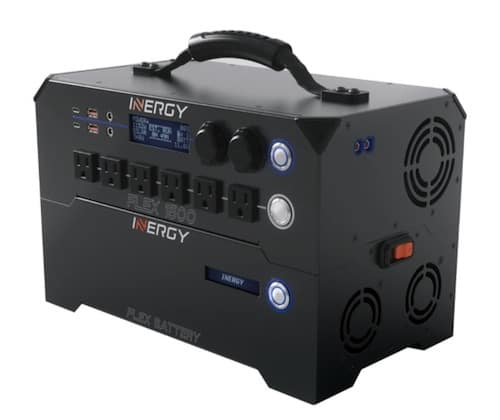 | 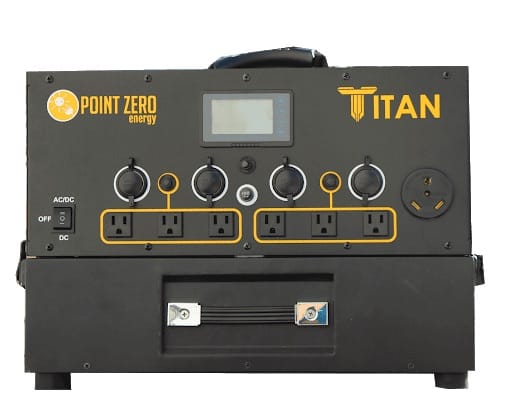 |
||
| Battery Type | AGM Lead-Acid | AGM Lead-Acid | Lithium-Ion | Lithium-Ion |
| Battery Capacity | 396Wh | 1,200Wh | 1,069Wh+ | 2,000Wh+ |
Just as important as it is to have solar generators, it is equally important to have replacement batteries for them.
In this article, I will expressly review these four solar generators with replacement batteries, and I will give a final verdict.
Similar: Top 15 Best Solar Generators for Camping (Small to Large
1. GOAL ZERO YETI 400
The Yeti 400 is one of Goal Zero’s first solar generators to use lead-acid batteries. Goal Zero is a company concerned about providing power solutions to homes, medical facilities, and even people on outdoor trips.
This solar generator is a quiet, portable solar generator with an impressive battery capacity of about 400Wh, 33Ah (12V).
These solar generators are chainable, and they have a replaceable solar lead-acid AGM battery weighing about 29lbs. Also, these solar generators feature numerous powering options including 2 USB, 2 AC outlets, and a 12V output. Furthermore, with the Yeti 400, you can power many small devices like smartphones, laptops, drones, and even household appliances.
You can comfortably power up mini-fridges and LCD TVs using this generator. Although, please note this generator can only power these devices and appliances for a specific amount of time.
As for the charge times, the Yeti 400 takes 31-62 hours to charge up using the Nomad 20 (light usage). For standard usage, make use of the Boulder 50 to charge the solar generator for 12-24 hours. Lastly, for heavy usage, use the Boulder 100 Briefcase (charges fully in 6-12 hours).
Interestingly, the Yeti 400 allows three charge methods. Using the sun, you can recharge the Yeti 400 comfortably. However, the charge time depends on the size of the solar panel. Another method of fully charging the Yeti 400 is by plugging it directly into the wall socket for 5 hours. Using a 12V car adapter, you will successfully charge up this solar generator for about 13 hours.
SPECIFICATIONS OF THE YETI 400
- Battery Capacity: 396Wh (12V, up to 33Ah)
- Battery Type: AGM Lead-Acid
- Lifecycles: hundreds of cycles
- Shelf-life: Keep plugged in, or charge every 3-6 months
- Management system: Charging and low battery protection built-in.
- Charge Times: 5 hours for a wall charger, and 12-24 hours for the Nomad 50 & Boulder 50.
- USB port (output): 5V, up to 2.1A (10W max), regulated
- 6mm port (output, 6mm, green, hexagon): 12V, up to 10A (120W max)
- 12V car port (output): 12V, up to 10A (120W max)
- Powerpole Chaining Port: 12V, up to 33A (400W max)
- Charging port (input, 8mm, blue, circle): 14-29V, up to 10A (120W max)
- Weight: 29 lbs
- Dimensions: 10.25 x 8 x 8 inches
WHAT YOU CAN POWER WITH THE YETI 400
- Smartphone: 20+ Recharges
- POV Camera: 70+ Recharges
- Headlamp: 70+ Recharges
- Tablet: 10+ Recharges
- Laptop: 3-5 Recharges
- Light-a-Life 130 Hours
- Mini Fridge: 7 Hours
- 32 LCD TV: 3 Hours
For more information, find the Yeti 400 user manual here.
GOAL ZERO YETI 400 REPLACEMENT BATTERY
The Yeti 400 replacement batteries are made from AGM Lead-Acid batteries with a lifecycle of over 100. Thanks to the battery management system, you are guaranteed charging and low battery protection.
The battery gets quickly charged when you connect the solar generator with any of the Nomad or Boulder solar panels. On average, the batteries take between 5 to 24 hours to get fully charged up.
SPECIFICATIONS OF THE YETI 400 REPLACEMENT BATTERY
- Battery Type: Lead Acid (AGM)
- Product SKU: 91008
- Shelf Life: Charge every three months
PROS
- Cost-effective
- Reliable
- Tolerant to overcharging
- Easily recyclable
- Delivers high current
CONS
- Very heavy and bulky
- Can overheat during charging
- Not suitable for fast charging
Similar: Goal Zero Yeti 400 Lithium Review – Best In Class
2. GOAL ZERO YETI 1250
The Yeti 1250 is a solar generator produced by Goal Zero and aimed at dealing with the issues of power in society.
As said earlier, Goal Zero has always been a company overly concerned about meeting the direct power needs of the people. Starting by just helping people, the company grew to be a significant producer of solar generators.
These solar generators are capable of powering up refrigerators, smartphones, drones, TVs, and other devices and appliances. With a battery capacity of over 1,200Wh integrated with a 1,200W pure sine wave inverter, it can power small and mid-range appliances.
Also, these solar generators do not emit fumes or make noise. With just the push of a button, you can get to enjoy the Yeti 1250.
Besides, the Yeti 1250 can power up medical facilities thanks to its versatile outputs. It has a 2.1A USB, 1,200W AC, and 12V capable of powering as many as ten devices at once. A commendable feature is that it’s easy to chain. You can extend the runtime of the Yeti 1250 by connecting it to other 12V, 100Ah batteries.
For the Yeti 1250, there are three ways to charge up the solar generator. By connecting to either the Nomad or Boulder solar panels, you can charge the Yeti 1250 comfortably. For the Boulder 200 Briefcase, it can fully charge your solar generator for as long as 12-24 hours.
You can also plug in these solar generators to the wall socket (fully charged in 18 hours). Interestingly, you can also make good use of the 12V car adapter to charge the Yeti 1250 for 44 hours.
SPECIFICATIONS OF THE YETI 1250
- Battery Capacity: 1,200Wh (12V, up to 100Ah)
- Battery Type: AGM Lead-Acid
- Lifecycles: hundreds of cycles
- Shelf-life: Keep plugged in, or charge every two months
- Internal Battery Dimensions: 12.9 x 6.8 x 8.7 inches
- Fuses: 200A (4 x 50A fuses in parallel)
- Management system: MPPT charge controller, low battery protection
- Charge Times: 18 hours for a wall charger, 44 hours for a car charger, and 36-96 hours for the Boulder 50. For the Boulder 100 & Boulder 200 solar panels, it takes 18-48 hours and 9-24 hours, respectively.
- USB port (output): 5V, up to 2.1A (10.5W max), regulated
- 6mm port (output): 12V, up to 6A (72W max)
- 12V car port (output): 12V, up to 10A (120W max)
- 12V power pole port (output): 12V, up to 33A (400W max)
- AC inverter (output, pure sine wave): 110VAC 60Hz, 10A (1,200W continuous, 1,500W surge max)
- Chaining Port (input, 8mm): 16-48V, up to 10A (160W max)
- Power pole charging port (input): 16-48V, up to 20A (320W max)
- Weight: 103 lbs
- Dimensions: 11 x 16 x 14.5 inches
WHAT YOU CAN POWER WITH THE YETI 1250
- Smartphone: 60+ Recharges
- POV Camera: 200+ Recharges
- Headlamp: 200+ Recharges
- Tablet: 45+ Recharges
- Laptop: 20+ Recharges
- Light-a-Life: 400+ Hours
- Mini Fridge: 20+ Hours
- 32 LCD TV: 12 Hours
For more information, find the Yeti 1250 user manual here.
GOAL ZERO YETI 1250 REPLACEMENT BATTERY
Like the Yeti 400 replacement batteries, the Goal Zero Yeti 1250 is made from AGM Lead-Acid batteries with a lifecycle of over 500-800.
Also, the battery management system guarantees charging and low battery protection. With an average of 18-96 hours, the battery gets charged up when connected with any of the Nomad or Boulder solar panels.
SPECIFICATIONS OF THE YETI 1250 REPLACEMENT BATTERY
- Battery Type: Lead Acid (AGM)
- Product SKU: 91009
- Shelf Life: Charge every three months
PROS
- Reliable battery for solar generators
- Quite resistant to shock
- Delivers very high current
- Has a very low impedance
- Easy to recycle
- Secure means of storing charges
CONS
- Prone to overheating during charging
- Doesn’t charge so fast
- Very heavy
My review post of the Yeti 1250 will give you some more insights on why it may or may not be a good system for you depending on how you use it. Find it here: Goal Zero Yeti 1250 Review & Analysis | Pure Power Solar.
3. INERGY FLEX
This solar generator is top-notch and provides reliable power for homes, outdoor applications, and even medical facilities. Inergy provides electricity for lighting, cooking, and warmth.
With this generator, you are saved from the need to use fuel or diesel products.
With an internal battery of over 1,000Wh, you are capable of powering up different types of devices and appliances from your smartphones up to your minifridges. Also, you can charge up your Inergy Flex by using a wall charger, solar charger, or even a car charger.
Interestingly, this solar generator allows for automatic battery balancing. The auto-balancing means the battery stays in a balanced position to remain safe and effective in operation.
SPECIFICATIONS
- Battery Capacity: 1,069Wh (12V, up to 100Ah)
- Battery type: Lithium-ion
- AC Inverter: 1,500W pure sine wave continuous, 3,000-watt surge
- Charging: 14-90VDC Solar Input, Standard Wall Charger/Car Charger Input, Combined maximum charge rate per flex battery (with optional Flex MPPT Supercharger): 1 hour
- Lithium-ion Battery Expansion: 96 Flex Batteries
- MPPT Charge Controller: 14-90VDC Solar input, 30A maximum battery charge rate
- 13.8V Regulated DC Power: Increases run time and stability for 12V devices
- Solar Array Options: Accepts series or parallel connection. 90VDC maximum, no amperage input maximum
- Dimensions: 14 x 8 x 8.9 inches
WHAT YOU CAN POWER
- Smartphone: 200+ Recharges
- Tablet: 50+ Recharges
- Laptop: 30+ Recharges
- Mini Fridge: 30+ Hours
- 32 LCD TV: 20+ Hours
- CPAP Machine: 50+ Hours
INERGY FLEX REPLACEMENT BATTERY
These batteries are stable and versatile. They are lithium-ion batteries with two Molex connector ports on both the top and the bottom panels for connecting to a Flex 1500 or Flex DC power console. The connectors are also helpful in connecting the batteries to an MPPT supercharger or another Flex Expansion Battery.
Furthermore, you can use this battery to expand the Flex 1500 solar generator. Also, you can use these batteries with the Flex DC Power Station. The cells are compact and relatively lightweight. The Flex lithium-ion batteries will double your storage capacity by about 1,069Wh of additional capacity.
You need a Flex Battery-to-Ring Terminal Adapter Cable to connect the battery to any Inergy model like the Kodiak or Apex. A notable feature of the Inergy Flex is its ability to take as many as 96 Flex Batteries (usually five batteries per vertical stack).
However, there are also critical battery safety features. The flex batteries have a lot of temperature sensors for smart cooling and battery protection. Also, these batteries feature an emergency shut-off control to protect the batteries from any kind of sudden damage.
Of course, the Inergy Flex also features an advanced BMS that monitors all the cell strings. Thanks to the smart data recording, you can track events that may damage the lifespan of these batteries.
SPECIFICATIONS OF THE INERGY FLEX REPLACEMENT BATTERY
- Battery Type: Lithium-ion
- Dimensions: 14 x 8 x 4.7 inches
- Weight: 16.5lbs
PROS
- Good for the environment
- Lasts long (but not good at all after about eight years)
- Requires limited maintenance
- Charges up fast
- Safe to use
CONS
- Requires protection
- Quite heavy
Similar: Goal Zero Vs. Inergy – Solar Generator Enterprise Match Up
4. POINT ZERO ENERGY TITAN
Point Zero is a company aimed at dealing with issues regarding power outages. Also, they believe in providing dependable power for smartphones, laptops, and other devices.
Moreover, their solar generators are aimed at providing power even during superstorm blackouts.
The Point Zero Energy Titan solar generators have efficient and quality components. Also, the solar generators have a removable expandable 2,000Wh lithium battery. Equipped with a 3,000Wh inverter, they provide just enough power for your devices and other household appliances.
The dual MPPT charge controllers also allow for fast charging. You would get an AC charger capable of supplying power for as long as four hours along with the Titan.
SPECIFICATIONS OF THE POINT ZERO TITAN
- Battery Capacity: 74Ah (usable) 2,000Wh (usable)
- Battery type: Lithium-ion
- Maximum Charge Current: 40A (approximately 1,000W)
- Battery Voltage: 29.4V (only charged to 29.2)
- Maximum Continuous Discharge: 100A (approximately 3,000W)
- Suggested Continuous Discharge (for long life): 1,500 Watts
- Maximum Surge Discharge Current (10 seconds or less): 300A (approximately 7,700 Watts)
- Output Voltage: 120V AC (pure sine wave)
- Continuous Power Output: 3,000 Watts
- Peak Power Output: 6,000 Watts
- Inverter (no-load power consumption): 5-15W
- Size (top portion not including the battery): 12 x 18.5 x 7.75 inches
- AC charging: 600 Watts per charger (up to 2 chargers max)
- Car port charging: 85 Watts
- USB Ports: 6 Smart USB, 2 USB-C
- Number of outlets: 6-15A, and one 30A RV outlet
- Weight: 32 lbs (67 lbs power module and battery)
- Dimensions: 18.5 x 12 x 12 inches
WHAT YOU CAN POWER WITH THE TITAN (PER BATTERY)
- Smartphone: 330+ Recharges
- Tablet: 66+ Recharges
- Laptop: 40+ Recharges
- Electric Blanket (Queen Size. 75 Watts): 26+ hours
- Mini Fridge: 36+ Hours
- Chainable USB LED Lights (6 Watts): 330+ hours
- 50 LCD TV: 30+ Hours
- CPAP Machine: 66+ Hours
For more information, find the Titan user manual here.
TITAN REPLACEMENT BATTERY
The Point Zero Energy replacement batteries are powerful and versatile. Also, they are known for their top-notch performance. For its capacity, the cells are relatively lightweight and safe to transport.
SPECIFICATIONS OF THE POINT ZERO REPLACEMENT BATTERY
- Battery Type: Lithium-ion
- Maximum Charge Current: 40A (approximately 1,000W)
- Battery Voltage: 29.4V (only charged to 29.2)
- Maximum Continuous Discharge: 100A (approximately 3,000W)
- Suggested Continuous Discharge (for long life): 1,500 Watts
- Dimensions: 12 x 18.5 x 4.5 inches
- Weight: 35 lbs
PROS
- Very stable
- High energy density
- Low self-discharge rate
- Easy and Fast to charge
- Safe to use and transport
CONS
- Requires protection
- A bit expensive
- Suffer from aging
I’ve analyzed the Titan extensively since it came out, and I recommend reading my review of it for comparisons, details on how it works with solar panels, as well as its port options. Find my review here: Titan Solar Generator Review – The Best Large Solar Generator?
USING SOLAR PANELS ALONGSIDE BATTERIES
Using solar panels is an effective way of charging up the battery of your solar generator.
Although it takes longer to charge the solar generator via panels in some cases, it is worth it because it is free energy and you can use it off the grid.
Solar panels are of different types:
- Monocrystalline
- Polycrystalline
- Thin-film
Typically, the monocrystalline solar panels have black cells; the cells appear black because of how light interacts with the pure silicon crystal.
For the polycrystalline solar panels, you can recognize them by their bluish hue to the reflected light off silicon cells. The thin-film solar panels have a thin structure and are made in several different formats.
SOLAR GENERATOR BATTERY TYPES

Whether you are making use of solar panels, wall sockets, or car chargers, you need a battery to store all that electricity. Interestingly, most solar generators are classified by their battery capacities.
In most cases, you’d discover that the more expensive the generator gets, the higher the battery capacity. So, a battery of 1,080mAh costs more than that of 500mAh.
Also, more battery capacity can power devices for extended periods of time.
There are two conventional batteries that are primarily used in building solar generators. Some solar generators make use of lead-acid batteries, but most of the new solar generators now make use of lithium batteries.
Here are some insights into these two types of cells for solar generators.
AGM SEALED LEAD-ACID BATTERIES
These batteries are commonly used in alarms, telecommunication, golf carts, mobility vehicles, and UPS. These batteries work efficiently, and also; they are safe to transport.
Thanks to its low internal resistance, you can recharge the AGM sealed batteries faster than the typical Flooded Lead Acid battery.
DEEP-CYCLE LEAD-ACID BATTERIES
These solar batteries are strictly for deep cycling. Usually, these batteries are discharged to 50% of their peak capacity and recharged again.
These batteries are classified by their amp-hour rating, which is a standard measure of battery capacity. On the downside, there are few recommendations on how to use these batteries, and this means it requires high maintenance.
LITHIUM-ION BATTERIES
Lithium batteries are not like lead-acid batteries.
Typically, lithium-ion batteries are used for portable electronics like smartphones and solar generators. Also, the cells are used in military and aerospace applications.
Unlike lead-acid batteries, lithium-ion batteries are maintenance-free and have a longer lifespan.
Lithium-iron-phosphate batteries
Lithium-iron-phosphate batteries, also known as “LiFePO4” or “LFP” batteries, are the longest-lasting battery types of the ones mentioned prior. They have a high cycle life, which means they can be charged and discharged typically thousands of times before the battery reduces its capacity.
LiFePO4 batteries also have a high DoD (depth of discharge), which means you can use most of its battery before recharging it without causing damage.
For more information on this battery type, check out this post by Solar Builder Magazine.
I have a list of the top LiFePO4 solar generators that you can browse to review each model’s cycle life. These power stations typically cost more upfront, but they easily outlast ones powered by lithium-ion and lead-acid batteries. You can read this post here: 6 Best LiFePO4 Solar Generators (Stats, Pricing, and Analysis).
FINAL VERDICT
Overall, pretty much all of the solar generators have good replacement batteries. Although from my experience, lithium batteries are the best bet.
However, the Titan and the Inergy Flex have the most impressive replacement battery features compared to all others. Also, notice the Battery Management System protects most of the replacement batteries.
When choosing a solar generator for use, strongly consider their replacement batteries. Hopefully, through the specifications and features discussed, this article will help you make a final choice when selecting which generator to purchase.
The Titan has the longest-lasting battery out of the four mentioned today. I have a full review post on this power station that compares it to others in its class. As you’ll see, it is capable of both high power output and high recharging speed. Find this post here: Titan Solar Generator Review – The Best Large Solar Generator?





